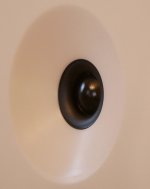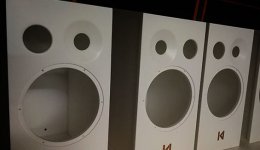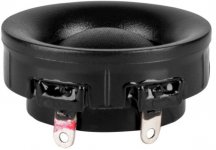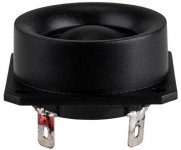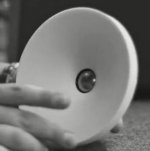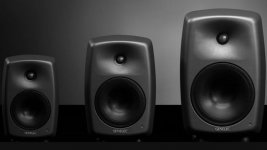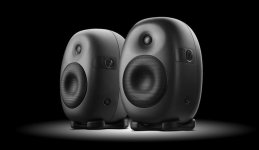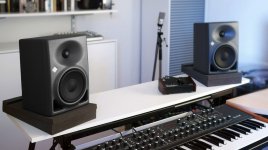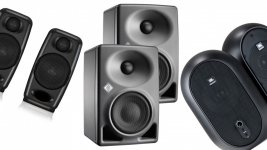I noticed that the Kroma Mimi monitor (SS 854x + OW1) uses a waveguide for the tweeter carved into the front baffle itself, which looks quite nice, IMO.
Does this generally work well and is it difficult to do from a woodworking perspective? Not sure how the tweeter is mounted on the inside plane.

Does this generally work well and is it difficult to do from a woodworking perspective? Not sure how the tweeter is mounted on the inside plane.
This article gives some theory; https://sound-au.com/articles/waveguides1.htm
I guess in practical terms it comes down to which profile & diameter router bit should be chosen?
A 45 deg bit will give a conical waveguide,
I guess in practical terms it comes down to which profile & diameter router bit should be chosen?
A 45 deg bit will give a conical waveguide,
Can you envisage what size you'd need and what it would take to fit it on a baffle arrangement.. Have you looked at the way separate waveguides are attached to dome tweeters..
From two extra photos, I can infer that this manufacturer has kept the tweeter's faceplate attached, so one can surmise that it's just screwed on flat to the inside of the front baffle. The baffle itself doesn't look particularly thick, so the screws/bolts for the tweeter cant be all that long; though they must be secure enough, I guess.
Attachments
Indeed. What I was concerned about is getting the job done in the space available without making things worse. The example is limited in size and doesn't have an added termination. It also has a problematic looking throat area.
There is evidence that simple baffle thickness waveguides can be capable of considerable diffraction.
There is evidence that simple baffle thickness waveguides can be capable of considerable diffraction.
Bingo on that name! I'd like to see / learn how to make these for whatever baffle thickness. Basically a carved shape that gets the baffle OUT OF THE WAY of a behind the baffle mounted driver's radiation, allowing it to appear as if it's mounted up on the baffle surface. With only the phase difference due to the added depth.baffle thickness waveguides
Interesting question which depends on what you're trying to do. For example...
For a woofer it may be preferred to radius the baffle cutout, and not much should come of it. With a tweeter you might keep the original properties with a tube the size of the diaphragm drilled through the baffle, with the outer rim treated to look like the tweeter faceplate. However you could introduce a pipe resonance, and perhaps concerns if the wavefront wasn't plane.
So that leaves making the waveguide shallow, wide and feathered onto the baffle plane. Of course it starts to look more like the baffle that way.. and raises the question of why?
For a woofer it may be preferred to radius the baffle cutout, and not much should come of it. With a tweeter you might keep the original properties with a tube the size of the diaphragm drilled through the baffle, with the outer rim treated to look like the tweeter faceplate. However you could introduce a pipe resonance, and perhaps concerns if the wavefront wasn't plane.
So that leaves making the waveguide shallow, wide and feathered onto the baffle plane. Of course it starts to look more like the baffle that way.. and raises the question of why?
In my case, I'd be attaching small (4" and under) FR speakers to thick open baffles. I want to keep the rear radiation of the driver as unencumbered as possible, so I want it mounted to the back of the baffle. That leaves a hole maybe 1.25" deep the front cone has to shoot through. I'm sure there's a shape that simply gets the baffle material acoustically out of the way, without modifying the driver's FR or polars - as if it was mounted on the front baffle surface.and raises the question of why?
I just dont know what that shape is. I would think it's all been done like everything else, just information that needs finding. Any assistance would be great!
20 years ago Finnish Amphion Argon revised edition 2 was quite popular and well regarded. Birch laminate and some CNC... Actually seating the tweeter must be done very carefully to avoid major interferences above 10kHz.
http://www.soundstagenetwork.com/revequip/amphion_argon2.htm
https://www.soundstagenetwork.com/measurements/amphion_argon_2/

http://www.soundstagenetwork.com/revequip/amphion_argon2.htm
https://www.soundstagenetwork.com/measurements/amphion_argon_2/
Last edited:
Thick wood baffle horn-porn. Ya, I can see it can be done. But how would I program a CNC to cut z depth as a function of r? What's the function?
I found a bowl someone made at a thrift store with an interesting shape - doesnt help much. Even if there were two...

I found a bowl someone made at a thrift store with an interesting shape - doesnt help much. Even if there were two...
Ah yes, Amphion have been doing this all along. I wonder how their tweeter is mounted, and if they remove the faceplate.20 years ago Finnish Amphion Argon revised edition 2 was quite popular and well regarded. Birch laminate and some CNC... Actually seating the tweeter must be done very carefully to avoid major interferences above 10kHz.
Although this photo shows they also use a discrete waveguide.
Attachments
Last edited:
No idea, I have a pair of HeliumII and some speakers with SEAS coaxials. They use(d) SEAS drivers and most likely the tweeter is 27mm alu unit like this one (spare) from their coaxials
https://cdn.shopify.com/s/files/1/0...-4298-8198-70899425a69b_650x.jpg?v=1617626032
You can find many similar tweeters if you search for automotive speakers
https://cdn.shopify.com/s/files/1/0...-4298-8198-70899425a69b_650x.jpg?v=1617626032
You can find many similar tweeters if you search for automotive speakers
Last edited:
They probably request Hiquphon for a specific OEM face-plate for the tweeter.From two extra photos, I can infer that this manufacturer has kept the tweeter's faceplate attached, so one can surmise that it's just screwed on flat to the inside of the front baffle. The baffle itself doesn't look particularly thick, so the screws/bolts for the tweeter cant be all that long; though they must be secure enough, I guess.
If they don't then it could be that they simply mill-out the face-plate (except the waveguide) and then use a "cup" (with it's own mounting) that pushes the tweeter to the baffle.
Does this generally work well and is it difficult to do from a woodworking perspective?
View attachment 1051871
It's *likely CNC cut - so it's no more difficult than a typical CNC cut (..though the synthetic marble would require a stronger/harder bit and likely liquid cooling.)
*though molding is also a possibility (particularly with some synthetic marble).
somewhere on this site people have made circular waveguides by rotating a curved profile "rake" over plaster or Bondo filler. the profile was probably an oblate spheroid (OS)
but I don't know about the gaps (in depth) you can see between the throat of the waveguide and the tweeter dome in the examples above, seems like diffraction trouble.
ideally you would want a tweeter without a grille and the horn throat could go right to the edge of the tweeter dome, like in that example posted by motokok.
also consider doing a small monitor with a "real" horn instead. commercial mini-monitors (JBL I have seen) are going in this direction.
you can put a dome or ring radiator in a small horn and cross it much lower than on a baffle, get better directivity match with the woofer. there are threads here about that too.
but I don't know about the gaps (in depth) you can see between the throat of the waveguide and the tweeter dome in the examples above, seems like diffraction trouble.
ideally you would want a tweeter without a grille and the horn throat could go right to the edge of the tweeter dome, like in that example posted by motokok.
also consider doing a small monitor with a "real" horn instead. commercial mini-monitors (JBL I have seen) are going in this direction.
you can put a dome or ring radiator in a small horn and cross it much lower than on a baffle, get better directivity match with the woofer. there are threads here about that too.
^ and all of those are going to be molded enclosures.
(..the Kroma Mini looks more like slab Corian in the same size panel used for baffle, top, bottom, and rear panels - and just milled for the baffle. One of the cool things about "Corian" and similar materials is that you can create a monolithic result with their "glue" which is effectively the exact same material as the panel itself - for joining those panels together, which is what the Kroma Mini looks like at the "joints" for those baffle, top, bottom, and rear panels. My grandparents had kitchen counter-tops & back-splash that were joined together in the same manner that created a monolithic panel, partly because my grandfather worked for Dupont - creators of Corian.)
Today, along with CNC, 3D printing is a viable means to achieve a similar result - especially if the print resolution is excellent (..as with many of the new Resin-based printers). 3D printing can also create forms for molds with other materials which might include casting a sufficiently dense polyurethane to achieve a look very similar to those molded enclosures above - like the less expensive designs from Genelec (..there more expensive loudspeakers are cast aluminum).
(..the Kroma Mini looks more like slab Corian in the same size panel used for baffle, top, bottom, and rear panels - and just milled for the baffle. One of the cool things about "Corian" and similar materials is that you can create a monolithic result with their "glue" which is effectively the exact same material as the panel itself - for joining those panels together, which is what the Kroma Mini looks like at the "joints" for those baffle, top, bottom, and rear panels. My grandparents had kitchen counter-tops & back-splash that were joined together in the same manner that created a monolithic panel, partly because my grandfather worked for Dupont - creators of Corian.)
Today, along with CNC, 3D printing is a viable means to achieve a similar result - especially if the print resolution is excellent (..as with many of the new Resin-based printers). 3D printing can also create forms for molds with other materials which might include casting a sufficiently dense polyurethane to achieve a look very similar to those molded enclosures above - like the less expensive designs from Genelec (..there more expensive loudspeakers are cast aluminum).
- Home
- Loudspeakers
- Multi-Way
- Waveguiding tweeter on front baffle itself
